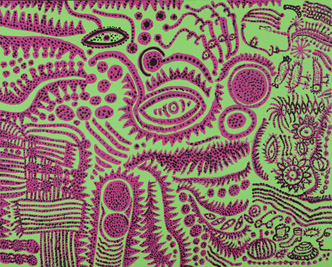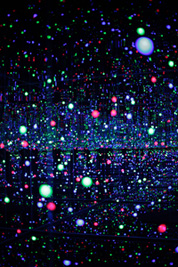 |
Focus features two in-depth reviews each month of fine art, architecture and design exhibitions and events at art museums, galleries and alternative spaces around Japan. The contributors are non-Japanese art critics living in Japan. |
|
|
 |
 |
 |
Dot to Dot: The Infinite World of Yayoi Kusama
Christopher Stephens |
 |
 |
|
 |
| Yayoi Kusama, Flowering New York, 2005 (©Yayoi Kusama Studio Inc., courtesy of Ota Fine Arts) |
|
Yayoi Kusama, Endless Life of People, 2010 (©Yayoi Kusama Studio Inc., courtesy of Ota Fine Arts)
|
Painting for Yayoi Kusama began as a way of escaping the relentless aural and visual hallucinations that plagued her, and of warding off the temptation to take her own life. Now 82, Kusama has managed to turn an obsession with polka dots, which have dominated her field of vision since childhood, into a long and prolific career. But rather than being an image of dread, the motif has come to represent hope, earning the artist an international following that stretches far beyond the walls of the museum.
Kusama's dots can be traced back at least as far as a pencil drawing she made at the age of 10 that depicted a kimono-clad girl with a downcast expression and a face covered with something resembling an outbreak of chicken pox. After considerable success and several solo exhibitions in Japan in the early '50s, Kusama defied her family's wishes and traded her hometown of Matsumoto (in Nagano Prefecture) for New York, inspired in part by an encouraging letter from Georgia O'Keeffe. Soon after, in 1958, a show of her distinctive "infinity net" paintings, made up of dizzyingly complex geometric patterns, was heralded by Donald Judd and others as an early example of the burgeoning Minimalist movement.
In the '60s, Kusama kept pace with the times by allying herself with youth and hippie culture, capturing attention in the tabloids with a series of happenings and anti-war protests in which she encouraged participants to shed their clothes and painted dots on their bodies. She also branched out into three dimensions with a series of "accumulation sculptures" -- ordinary objects like rowboats, tables, and chairs that were lined with soft silver phalluses -- and mirrored rooms with endless reflections of dots or dot-covered objects. This era of frantic activity came to an abrupt end with the death of Kusama's close friend and lover Joseph Cornell in 1972, prompting her to return to Japan and seek psychiatric help. In the intervening 40 years, Kusama has spent her days in her Shinjuku studio and her nights in the open ward of a mental hospital across the street.
Though not completely inactive in the '80s, Kusama concentrated primarily on writing. She published several novels, including The Hustler's Grotto of Christopher Street, based on her experiences in New York. It wasn't until the '90s that she regained her footing in the art world, representing Japan at the Venice Biennale in 1993 and appearing in a number of foreign retrospectives. But instead of merely looking back at her past, in 2004 Kusama began a startling new series titled Love Forever that marked the start of what is probably the most fertile period in her career. It is this group of works, and a selection from a second series, My Eternal Soul, that are now on view in the Eternity of Eternal Eternity exhibition at the National Museum of Art, Osaka.
 |
|
 |
| Yayoi Kusama, Flowers in the Field, 2011 (©Yayoi Kusama Studio Inc., courtesy of Ota Fine Arts) |
|
Yayoi Kusama, Gleaming Lights of the Souls, 2008 (©Yayoi Kusama) |
Kusama's mode of expression in both series is more approachable than much of her past work thanks to the inclusion of clearly identifiable motifs such as eyes, faces in profile, and flowers. While Love Forever, a group of 50 works produced over a three-year period, is made up entirely of white canvases filled with line drawings in black marker, My Eternal Soul bursts with brilliant acrylic blues, reds, and yellows, and though it contains some of the same concrete elements, it tends more toward the abstract. Many of the 47 works from the latter series (which now numbers over 100 pictures) feature what appear to be microorganisms surrounded by a jagged border of triangles. Kusama's dots are also present but function more as an accent than a blanketing pattern.
The exhibition, which began just after the new year, will travel to three more venues in Saitama, Matsumoto, and Niigata before it closes in late December. Meanwhile, a wide-ranging retrospective of Kusama's work is currently on view at the Tate Modern in London, where it arrived after opening last May in Madrid and stopping at the Centre Pompidou in Paris. It will wind up in New York in the fall. A theatrical film about the artist, I Adore Myself, was also released in 2008, followed by a three-hour documentary that aired on NHK last August (both directed by Takako Matsumoto), and an English translation of Kusama's 2002 autobiography, Infinity Net, has just been published.
In recent years, Kusama has established herself as a master marketer on the order of Andy Warhol. In addition to spotted pumpkin cellphone straps and a plethora of printed items (stationery, origami paper, etc.) on offer at the Osaka museum, Kusama has teamed up with a local pâtissier, hotel, and lingerie company to produce official roll cakes, omelettes, and underwear, respectively.
As it happens, Damien Hirst is currently showing his "spot" paintings in eight cities, including New York, London, and Rome. His explanation of the works -- "I want them to be sort of infinite" -- has a familiar ring. Asked for her thoughts on Hirstfs series at a press conference for her exhibition at the Tate, Kusama said, "I am very happy that the polka dots that I started using [as a young girl] have become a symbol of love and peace . . . with everyone joining hands to use them together in this way." The whole world appears today as it has to Yayoi Kusama for decades -- completely covered with dots.
 |
|
Portrait of the artist (©Yayoi Kusama)
|
|
|
|
|
 |
 |
Christopher Stephens
Christopher Stephens has lived in the Kansai region for close to 25 years. In addition to serving as the editor of the now defunct magazine Kansai Time Out for many years, he has extensive experience as the translator of numerous exhibition catalogues for museums throughout Japan, and art and architecture books such as What's Gutai?, The Architecture of E.G. Asplund: 1885-1940, Salon to Biennial, World Architects 51, Miwa Yanagi: Windswept Women, Tomoko Konoike's Inter-Traveller, and Tadanori Yokoo's Tokyo Y-Junctions. |
|
 |
|